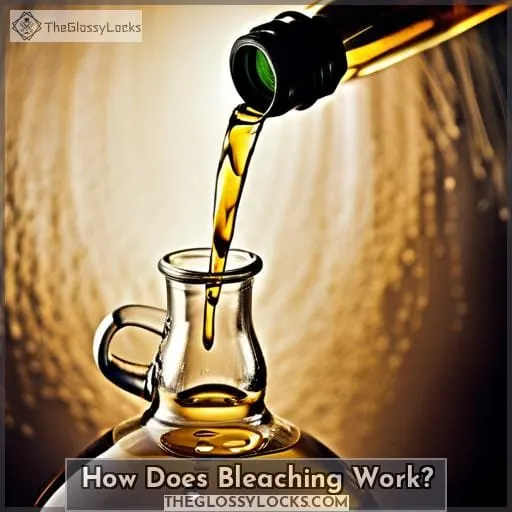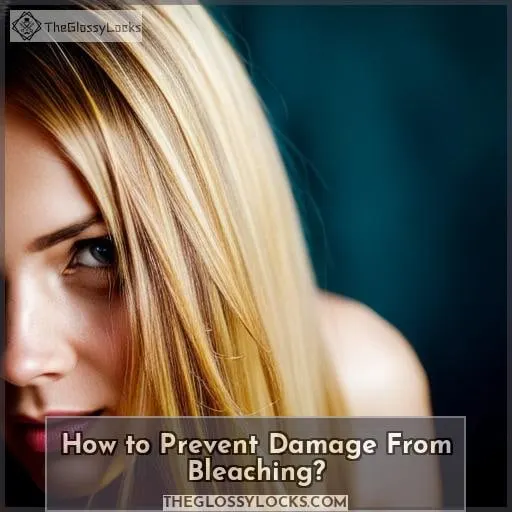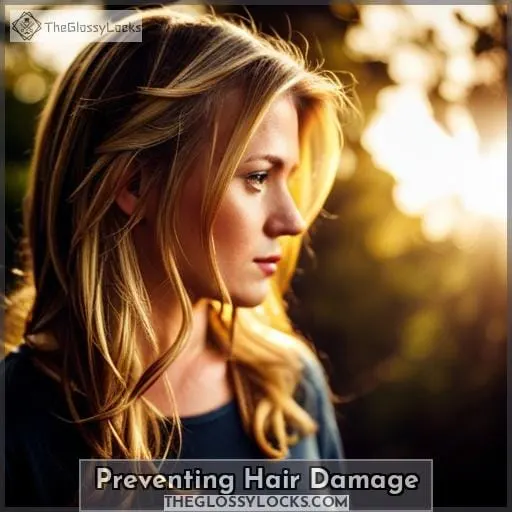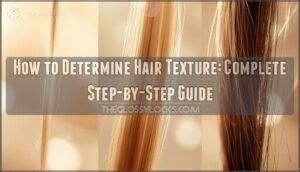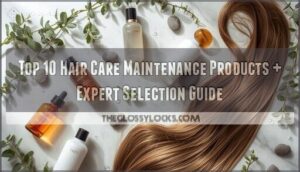This site is supported by our readers. We may earn a commission, at no cost to you, if you purchase through links.
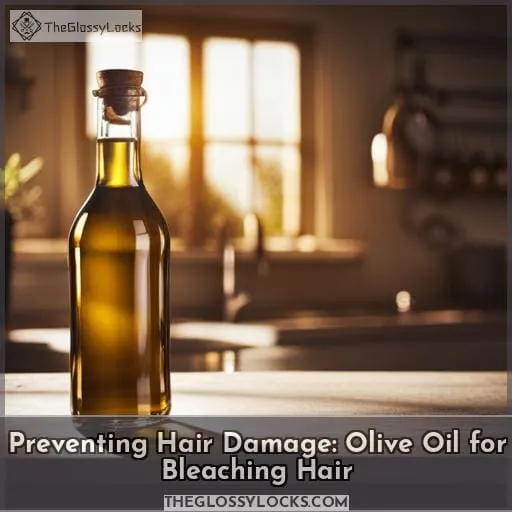
Yes, you heard right! By applying organic olive oil before bleaching, you can nourish and strengthen your hair, minimizing the risk of irreparable damage. This simple step can make all the difference in maintaining healthy and beautiful tresses throughout any hair transformation journey.
Table Of Contents
- Key Takeaways
- How Does Bleaching Work?
- Is It Dangerous to Bleach?
- How to Prevent Damage From Bleaching?
- Final Decision?
- Will I Ever Do It?
- Preventing Hair Damage
- Frequently Asked Questions (FAQs)
- Can olive oil completely prevent damage from bleaching?
- Can olive oil be used during the bleaching process to minimize damage?
- Is olive oil suitable for all hair types when used before bleaching?
- Can olive oil be used as a post-bleaching treatment to repair damaged hair?
- Does applying olive oil before bleaching affect the final outcome of the hair color?
- Conclusion
Key Takeaways
- Olive oil can be used as a pre-shampoo treatment before bleaching hair to minimize the risks of dryness, breakage, and texture changes.
- Olive oil provides hydration, soothes the scalp, and reduces frizz when applied before bleaching hair.
- Other alternative oils, such as coconut oil, argan oil, and almond oil, can also be used for deep nourishment, lightweight hydration, and strengthening and adding shine to the hair before bleaching.
- It is important to personalize hair care by choosing the right oil based on hair type and needs and to prioritize deep conditioning and consistent use of leave-in conditioners for post-bleach care.
How Does Bleaching Work?
Bleaching works by oxidizing the cuticles of your hair, removing its natural color and allowing it to go several shades lighter. This process is achieved through the use of bleach and hydrogen peroxide, which strip away the pigments in your hair.
The effectiveness of bleaching depends on various factors such as hair porosity and initial color.
It’s important to note that while bleaching can give you a desired lightened look, it can also cause damage to your hair health if not done properly or maintained correctly afterwards. Hair damage from bleach includes dryness, breakage, and changes in overall texture.
To minimize these risks, incorporating pre-shampoo treatments like olive oil into your hair care routine can help nourish and protect your strands before undergoing the bleaching process.
Is It Dangerous to Bleach?
If you’re considering bleaching your hair, you may be wondering if it’s dangerous.
Bleaching can be risky if not done by a professional with expertise in the process. DIY attempts can lead to melted hair or burned scalp due to incorrect application or timing.
It’s important to note that bleach should never be applied on already damaged hair without undergoing an intense reparation process beforehand. Hair health should always come first when making personal choices about bleaching.
If damage does occur, there are ways to repair and restore the health of your hair through personalized routines and extra protein treatments aimed at replenishing lost keratin from the bleaching process.
Ultimately, whether or not one decides to bleach their hair depends on weighing the risks against desired outcomes and prioritizing overall hair care and well-being.
How to Prevent Damage From Bleaching?
To prevent damage from bleaching, you should regularly incorporate nourishing treatments into your hair care routine.
- Use nourishing oils: Olive oil, coconut oil, argan oil, and almond oil can all provide hydration and protection for your hair. Apply these oils before or after bleaching to minimize damage.
- Consider color correction: If you’re not happy with the results of DIY bleach jobs, it’s best to seek professional help for color correction instead of trying to fix it yourself.
- Prioritize post-bleach care: After bleaching, focus on repairing and moisturizing damaged strands through regular use of deep conditioning treatments and leave-in conditioners.
By following these steps consistently in your hair care routine, you can significantly reduce the risk of hair breakage caused by bleach while achieving desired lightened locks without compromising its health.
Final Decision?
Make a final decision on whether or not to bleach your hair. While bleaching can give you the lightened look you desire, it’s important to consider the potential damage it can cause.
Bleaching opens up the cuticles and strips away natural pigment, leaving hair more porous and vulnerable.
If you choose to bleach your hair, be prepared for consistent treatments and personalized care to repair any damage caused.
However, if you’re hesitant about bleaching, opting for a haircut may be a safer choice that doesn’t compromise your hair’s health as much.
Trusting in a routine of proper maintenance and nourishment is key when dealing with damaged or chemically treated hair like olive oil treatments before bleaching can help minimize harm but can’t completely prevent it.
Ultimately, weigh the pros and cons carefully before making your final decision regarding whether or not to bleach your precious locks.
Will I Ever Do It?
Now that you’ve weighed the pros and cons of bleaching your hair, it’s time to consider whether or not you’ll ever take the plunge.
Hair dilemmas can be tough to navigate, especially when it comes to making major beauty transformations. Your personal routine and styling decisions play a crucial role in maintaining healthy hair.
The idea of using olive oil before bleaching may have piqued your interest as a preventative measure against potential damage. Incorporating olive oil into your haircare choices could be a game-changer in preventing hair damage during the bleaching process.
By following a well-structured and consistent hair routine, which includes nourishing treatments like applying organic oils such as olive oil, you can significantly reduce the risk of damaging your precious locks while achieving those desired lightened strands.
Whether or not you’ll ever bleach is ultimately up to you; just remember that taking care of your tresses should always come first.
Preventing Hair Damage
To prevent hair damage when bleaching, there are several steps you can take.
- One is to apply organic oils such as olive oil or coconut oil to your hair the night before bleaching.
- Additionally, using sun protection, DIY hair masks, leave-in conditioner, and avoiding heat styling can all contribute to keeping your bleached hair healthy and hydrated.
Olive Oil
You can use olive oil as a preventative measure to protect your hair from damage when bleaching.
- Olive oil has nourishing benefits that help keep your hair healthy and hydrated.
- It can address scalp concerns by moisturizing and soothing the skin.
- Styling challenges, such as frizz or dryness, can be minimized with the regular use of olive oil.
Using olive oil in your hair care routine will provide added protection and promote overall hair health.
Coconut Oil
To prevent hair damage when bleaching, apply a small amount of coconut oil to nourish and protect your strands.
Coconut oil is rich in fatty acids that penetrate the hair shaft, reducing porosity and preventing moisture loss.
Incorporate regular scalp massages with coconut oil to increase blood circulation and stimulate hair growth. Additionally, use coconut oil as a natural sun protector before going out in the sun or swimming in chlorinated water.
| Benefits of Coconut Oil for Hair | How to Use Coconut Oil |
|---|---|
| Reduces Hair Porosity | Apply it as an overnight treatment before washing your hair |
| Prevents Moisture Loss | Massage onto scalp regularly for increased blood circulation |
| Promotes Healthy Scalp | Use it as a pre-swim treatment to protect against chlorine |
Coconut oil is an excellent option for preventing damage during bleaching due to its ability to deeply nourish and moisturize the hair without weighing it down. Its natural properties make it beneficial not only for protecting against heat styling but also providing protection from environmental factors such as chlorine exposure or excessive sunlight.
Argan Oil
Continuing the exploration of preventing hair damage, let’s now delve into the benefits of incorporating argan oil into your bleaching routine.
Argan oil offers numerous advantages for maintaining healthy hair during and after bleaching. It’s lighter than coconut oil, making it ideal for those with fine or straight hair.
You can use argan oil as a pre-bleach treatment to nourish and protect your strands. Additionally, argan oil can be used in DIY hair masks or as a styling product for added shine and hydration.
Almond Oil
To further protect your hair from damage, consider incorporating almond oil into your hair care routine.
Almond oil offers numerous benefits for nourishing and protecting your hair. It helps to moisturize and strengthen the strands, reducing breakage and improving overall health.
Additionally, almond oil can be used as a styling aid to add shine and smoothness to your locks.
However, it’s important to note that almond oil may not be suitable for all hair types due to its weightiness on fine or straight hair.
Use Sun Protection
Now let’s talk about how you can protect your hair from sun damage.
- Use sunscreen for hair to shield it from harmful UV rays.
- Wear a hat for added protection against the sun’s rays.
- Look for products with UV shield technology to prevent color fading and damage.
- Apply a leave-in conditioner or oil with SPF before going out in the sun.
- Consider using sunblock solutions specifically designed for hair to provide an extra layer of defense.
DIY Hair Masks
In the article, we discussed the importance of using sun protection for preventing hair damage caused by bleaching.
Avocado treatments can provide deep hydration and nourishment to damaged hair.
Honey has benefits such as promoting moisture retention and reducing split ends.
Egg white masks can help strengthen the hair shafts and promote regrowth.
Incorporating scalp massages into your routine can improve blood circulation and stimulate healthy hair growth.
Rice Water Rinse
Continuing the discussion on preventing hair damage, let’s now explore how frequently incorporating a rice water rinse into your hair care routine can help nourish and protect bleached hair.
Rice water benefits include natural hydration and moisture retention, making it an excellent alternative rinse for DIY hair treatments. By using rice water regularly, you can provide your bleached locks with essential nutrients that promote healthier and stronger strands.
Leave-in Conditioner
To prevent hair damage when bleaching, it’s crucial for you to regularly use a leave-in conditioner. This will help keep your hair hydrated and protected throughout the bleaching process.
The benefits of using a leave-in conditioner include:
- Added moisture
- Reduced breakage
- Protection against damage
When applying the leave-in conditioner, be sure to distribute it evenly from roots to ends for maximum effectiveness. Consider using a lightweight formula that won’t weigh down your hair or affect the color outcome.
Avoid Heat Styling
Minimize potential damage to your bleached hair by avoiding excessive heat styling.
Heat tools like flat irons, curling wands, and blow dryers can further weaken and dehydrate already fragile strands.
Instead, opt for air drying or using low-heat settings when necessary.
Protect your hair from the sun’s rays by wearing a hat or applying a UV protectant spray before heading out.
Additionally, incorporate hydrating hair masks into your routine to nourish and restore moisture lost during the bleaching process.
Be cautious with chlorine exposure as it can exacerbate damage and cause discoloration in bleached hair.
Be Careful With Chlorine
Looking to protect your bleached hair? How can you ensure that chlorine doesn’t cause further damage? Here are some pool hair tips to help you take care of your hair during the summer swim season:
- Wet Your Hair Before Swimming: By wetting your hair with fresh water before entering the pool, it can help minimize the amount of chlorine absorbed.
- Wear a Swim Cap: A swim cap creates a protective barrier between your hair and chlorinated water.
- Rinse Immediately After Swimming: Rinse off any residual chlorine from your hair as soon as possible after swimming.
- Use a Clarifying Shampoo Once a Week: This will help remove any build-up of chemicals or impurities from chlorinated pools.
By following these simple tips, you can enjoy swimming while minimizing the potential damage caused by chlorine exposure and keep bleach-treated locks looking their best throughout the summer months!
Frequently Asked Questions (FAQs)
Can olive oil completely prevent damage from bleaching?
Applying olive oil before bleaching hair can help minimize damage, but it can’t completely prevent it. Olive oil nourishes and moisturizes the hair, providing some protection during the oxidation process, but caution should still be exercised to avoid excessive damage.
Can olive oil be used during the bleaching process to minimize damage?
During the bleaching process, applying olive oil can minimize damage by acting as a protective barrier. Think of it like wearing armor to shield your hair from the harsh effects of bleach.
Is olive oil suitable for all hair types when used before bleaching?
Before bleaching, it’s important to consider your hair type.
Olive oil can be beneficial for dry or kinky/curly hair, but it may weigh down fine or straight hair.
Evaluate your specific needs and choose the appropriate treatment accordingly.
Can olive oil be used as a post-bleaching treatment to repair damaged hair?
Using olive oil as a post-bleaching treatment can help repair damaged hair.
Its moisturizing properties nourish and restore the hair, promoting healing and preventing further damage.
Embrace the power of olive oil for healthier, more vibrant locks.
Does applying olive oil before bleaching affect the final outcome of the hair color?
Applying olive oil before bleaching can create a barrier that helps protect hair from damage. However, it may affect the final outcome of the hair color by potentially interfering with the bleach’s ability to fully penetrate and lighten the hair.
Conclusion
To protect your hair from damage while bleaching, incorporating olive oil is a game-changer. By nourishing and strengthening your hair with this natural ingredient, you can minimize the risk of irreversible harm.
Olive oil, along with other oils like coconut, argan, and almond, can provide the necessary hydration and protection to keep your locks healthy throughout any hair transformation.
Additionally, using sun protection, DIY hair masks, rice water rinse, leave-in conditioner, and avoiding heat styling and chlorine can further safeguard your strands.
So, go ahead and achieve that desired lighter hue without compromising your hair’s health.

